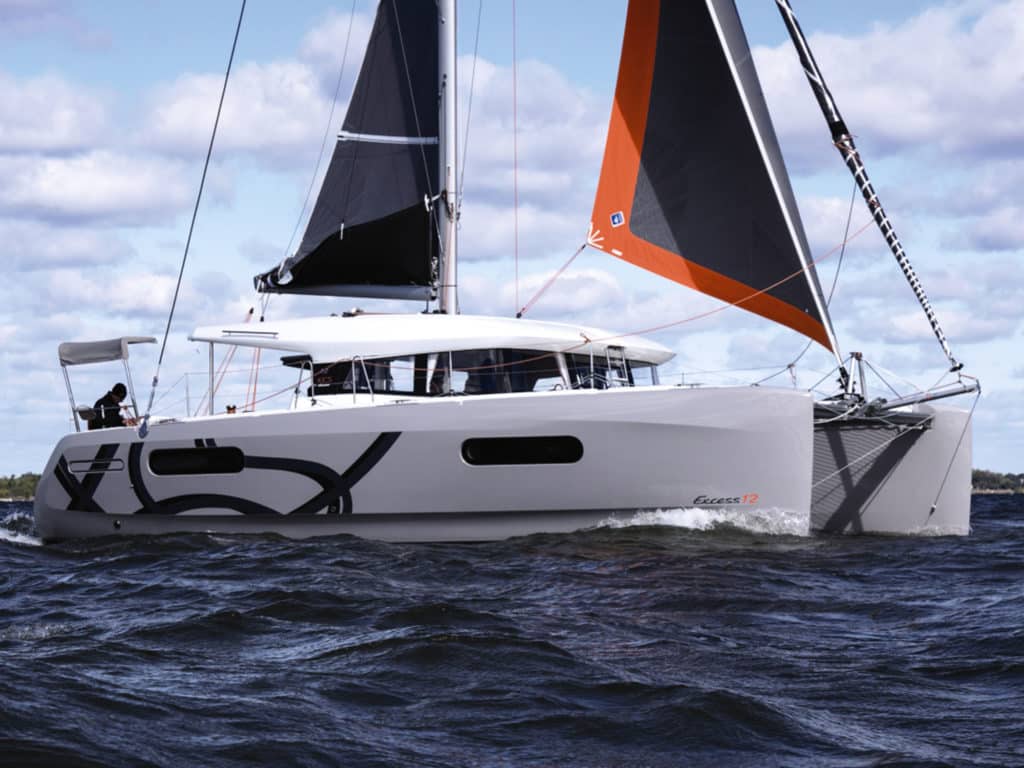
France’s Groupe Beneteau coined the phrase “be immoderate” to promote its new Excess Catamarans brand.
So, we were.
On a day when a forecasted gale set off a wave of sea-trial postponements during the week following the U.S. Sailboat Show in Annapolis, Maryland, Excess regional sales director Frédéric Signat insisted that the Boat of the Year judging should go on as planned. It turns out, he was right. Not only did we have one heck of a ride before gusts topped 40 knots and convinced us it was time to drop the double-reefed mainsail and motor home, it was so good that the judges later named the Excess 12 the Best Midsize Cruising Catamaran for 2020.
The Excess line was launched to offer a sportier alternative to what’s currently available in production catamarans—including Groupe Beneteau’s competing Lagoon range—without getting into the complexity and price of boats with daggerboards and built using exotic fibers. A company representative said the idea was to come out with a cat for sailors who might be looking for the space afforded by two hulls but didn’t want to give up the responsiveness and feel of sailing a monohull.
To achieve this—compared with say, a Lagoon 40—the 38-foot-5-inch Excess 12 has a powered-up sail plan that includes a flattop main and self-tacking jib, and optional sprit and screecher (an even taller and peppier Pulse rig is also available). Designers also looked for ways to reduce weight, so there’s less furniture in the saloon and cabins. Hanging lockers were replaced with fabric garment bags, and drawers with cupboards, for instance. But when you approach the boat, what you first notice are the twin wheels that are located outboard and far aft on either hull, rather than up on a bulkhead or atop a flybridge, both of which are the more common locations for a multihull’s steering station. With all sail-control lines leading to the wheels, the experience of driving the Excess is not all that different from sailing many of the wide-beam twin-wheel monohulls we’ve seen in recent years.
It was a feature that BOTY judge Ed Sherman applauded. “You know, it engages whoever is at the helm with the rest of the crowd on the boat. I think it’s safer. I prefer to be lower than higher when I’m driving a boat,” he said.
Fellow judge Dan Spurr agreed. But he was equally impressed with the convertible Bimini over the cockpit, the center of which slides open to allow an unobstructed view of the mainsail, or it can be closed for shade or in bad weather. “I thought it was more lively than the other boats we sailed,” he said.
The Excess 12 was the first of the new line to reach the US. This fall, we’ll see the 37-foot Excess 11 alongside the flagship 48-foot Excess 15. Two other models, the Excess 13 and 14, will eventually follow.
The 12 is available in three layouts. The boat we sailed is the three-cabin, two-head version. The owner’s quarters are in the port hull, and include a queen-size berth aft and a head and shower forward. Two double cabins share a single head and shower in the opposite hull. There is also a four-cabin version, with either two or four heads.
Underway, the Excess was pretty easy to handle, even in boisterous conditions. Once the sails were set and sheeted in (no need for the screecher that day), tacking required just a turn of the wheel. In 25 to 30 knots of breeze and higher gusts, we scooted right along at better than 8 knots, both closehauled and reaching, and the steering felt quite nimble. Though we kicked up a good bit of spray, both helms were dry, and it was pretty cool to sit down close to the water and watch it fly by. I found the soft-back fold-down helm seats, which also close off the transom steps, to be quite comfy. When I first took the wheel, I noticed the aft corner of the cabin created a blind spot, but by moving around a bit, I was able to compensate for it.
Under power, at cruising rpm (2,000), the twin Yanmar 29 hp engines and saildrives pushed us along at 6.5 knots, even into the wind, and we added a knot with the throttles wide open.
Back in college, graffiti in a local watering hole read, “Anything worth doing is worth doing to excess.” After getting a chance to sail the new Excess 12 on a very blustery day, I’d have to agree.
Mark Pillsbury is CW’s editor.








